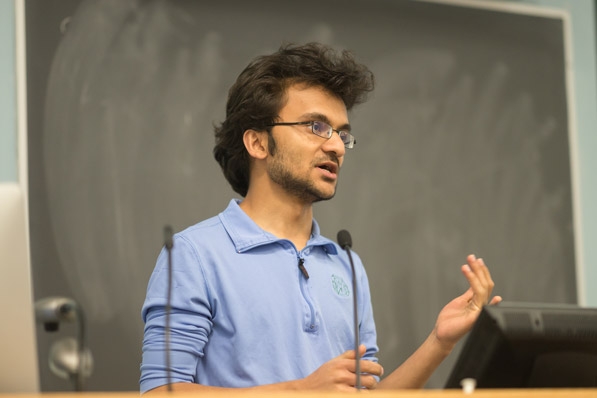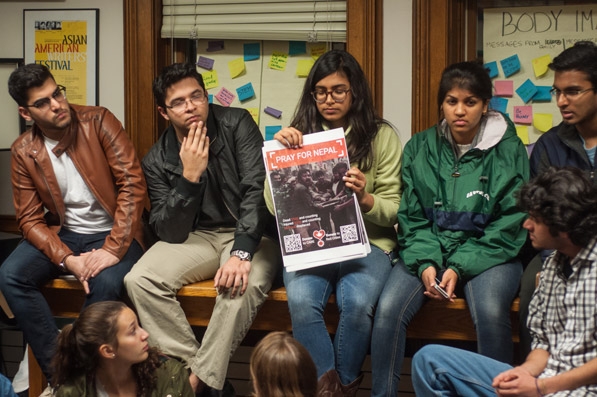More than 100 people from Dartmouth and the Upper Valley community gathered at the College last night to discuss the urgent mission of getting aid to Nepal, where more than 5,000 people died and half a million are homeless after the massive earthquake on April 25.

Pawan Dhakal ’16 spoke at the April 28 meeting to discuss getting aid to Nepal. (Photo by Eli Burakian ’00)

Among those who gathered at the April 27 student meeting in response to the earthquake are, from left, seated on bench: Raunak Bhojwani ’18, Yohann Curmally ’18, Juhi Kalra ’16, Apoorva Dixit ’17, and Anwesh Dash ’18. (Photo by Kwame Ohene-Adu ’14)
The Dartmouth effort will coordinate through the web domain www.dartmouth.edu/for-nepal, under construction by Nepalese student Pawan Dhakal ’16 and Thayer School of Engineering graduate student Aditya Mahara, with support from the provost’s office. Dhakal and Mahara told those gathered at the meeting that the student group is working with the provost to organize a central Dartmouth fund to gather donations and organize College fundraising work around Nepal.
Dartmouth Community Members Voice Concern for Nepal
Many offer their perspectives, including students, researchers, foundation members, and others. Read the story.
The gathering, organized by Sienna Craig, associate professor of anthropology and chair of the department, and Kenneth Bauer, program manager of human development initiatives at the John Sloan Dickey Center for International Understanding, was focused on sharing information between people already involved in relief work, and offering options for people looking for ways to help.
How You Can Help
Financial contribution to earthquake relief efforts in Nepal are best made to the following organizations, say Associate Professor Sienna Craig and Lecturer Kenneth Bauer:
- American Nepal Medical Foundation
On the ground in Nepal since 1997, the foundation is run by Nepali doctors in conjunction with U.S. physicians.- Educate the Children
A respected group with experience in rural areas that works to improve the lives of women and children.- Mercy Corps
Works throughout Nepal with decades of experience in emergency relief in places experiencing conflict, disaster, and political upheaval.- Other vetted charities
Links to several non-governmental organizations that have set up funds to support relief efforts in Nepal.
Bauer began with a minute of silence for the earthquake victims, and then outlined the goals for the meeting.
“We are here to focus on what we can do, both to help with the urgent needs of rescue and relief, and to envision a response for the long term beyond the immediate wave of attention and beyond the capital, out in the devastated rural areas,” he said.
Bauer described three “action clusters” for response: infrastructure, health, and human development, all of which include short-term and long-term needs. For example, in the area of human development, the community can donate directly to organizations providing immediate relief, such as temporary shelter and supplies, while developing long-term targeted partnerships in specific rural areas to help communities rebuild their physical, social, spiritual lives.
Relief efforts highlighted at the meeting:
- Bhupesh Khadka, a physician at Dartmouth Hitchcock Medical Center, is leaving Friday for Kathmandu through the America Nepal Medical Foundation. He told the gathering that he is collecting medical supplies such as surgical kits, braces, suture kits, and antibiotics, as well as funds through the foundation to transport to Nepal, where he will be working with a team in the capital.
- Christina Hammond of the American Red Cross International Response Unit said that donating to the Red Cross or other vetted relief groups is an effective approach for people who want to do something right away. There are 100,000 Nepalese Red Cross volunteers in place and established supply chains with neighboring countries for emergency supplies like temporary shelter and water. Direct cash donations can help on many levels, she said, by providing needed supplies and services, but also by empowering those in Nepal by supporting local businesses and workers. “The people of Nepal need help, but they are not helpless,” she said.
- Craig said friends and colleagues have been working with NASA and a number of other organizations to help crowdsource mapping work. The sites share high resolution images to try to get a sense of the extent of the devastation, especially outside of the Kathmandu valley, where access remains limited. Bauer said that anyone can log on and flag sites like bridges, roads, schools, and hospitals damaged or surviving in remote regions. “It is an opportunity to be an armchair relief worker,” Bauer said. Crisis mapping sites include:http://quakemap.org/; http://crisismappers.net/; andhttp://services.digitalglobe.com, username: Nepal, password: forcrisis; and links to these sites and others will be posted on the www.dartmouth.edu/for-nepal site.
- Shreya Shrestha, a rural health scholar at the Geisel School of Medicine, said her group is working in the Upper Valley to inventory medical materials that may be made available for Nepal relief through the America Nepal Medical Foundation and other organizations.
- Milan and Dartmouth Nepalese students are looking at sponsoring fundraisers and manning information booths to raise awareness about the Nepal disaster response.
- Bhola Pandey, owner of the Base Camp Cafe in Hanover, is donating proceeds from Monday night meals to Nepal relief. Pandey is raising money to buy a brick-making machine to help a Nepalese village rebuild.
- The Dartmouth College Wind Ensemble will take time at its concert on Saturday, May 2, at 8 p.m. in Spaulding Auditorium to raise awareness about the Nepal disaster and share with the audience information on how to support the Dartmouth College relief efforts.
- Bauer and Craig have organized a list of “reputable international emergency humanitarian agencies with durable Nepal ties,” including the Red Cross, America Nepal Medical Foundation, and Mercy Corps. Reconstruction aid, especially to rural areas, can be sent through small nongovernmental organizations that have been working in affected areas, including Educate the Children, Nepal Seeds, and One Heart World-Wide. “There are many, many organizations and ways to help, so it is important to emphasize that these are not the only organizations or ways to help, and there will be many long-term, continuing needs,” Bauer said.
For updated information, to share resources, or to find ways to help, Bauer and Craig encourage the community to look for updates to the Dartmouth Nepal website.
